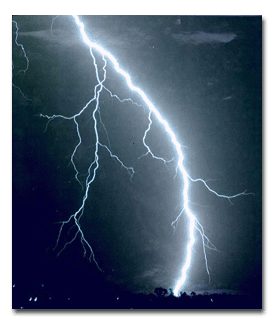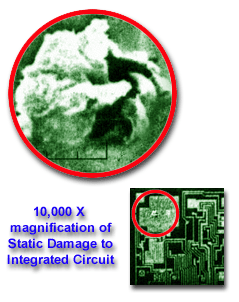Lightning & Static Electricity Damage
Lightning is the transient passage of electrical current between a cloud and either the surface of the earth, another cloud, or an object in or near a cloud.
Lightning causes damage to equipment in three different ways:
1) There can be damage as a result of a direct lightning strike.
2) Part of the lightning current can be carried inside a building by electric power, telephone, analog or digital data lines (e.g., closed circuit television cameras, sensors, etc.). This direct injection of lightning current inside a building can cause immense damage to electrical - and especially electronic - circuits and equipment.
3) The electromagnetic fields from the current in a lightning stroke can induce currents and voltage in wire and cables inside a building. Such surge currents are typically less intense than direct injection of current, but can easily vaporize integrated circuits in computers, modems, electronic control circuits, etc.
Electronic equipment is typically designed to operate in a well-controlled electrical environment. It is the responsibility of the user to install lightning protection, electrical surge-protective devices, and power conditioning equipment to mitigate the effects of disturbances in the electrical voltage waveform. It is well recognized that the trend toward integrated circuits with more transistors per unit area, and faster switching speeds, makes these circuits more vulnerable to both lockup and damage.
Aside from surge currents that are conducted on wires or cables, there can also be damage from magnetic fields associated with lightning currents. For example, lightning current that travels to earth along reinforcing steel inside a concrete wall or column can produce a rapidly changing magnetic field that can erase floppy disks or computer tapes inside a storage cabinet. Further, this rapidly changing magnetic field can induce a surge current in loops of wire or cable that are common in computer systems, and such surge currents can cause damage or lockups in the same way as direct injection of lightning current into wires and cables.
Lightning current can travel for long distances on overhead power lines, or in underground pipes and cables, so that a user who experiences lockups or damage may not recognize that it coincided with a lightning strike some distance from the user.
Consequential Damages:
- Loss of business income while equipment is inoperative
- Cost of reloading & configuring software programs
- Cost of restoring data from backups and paper records
- Cost of replacing or repairing damaged equipment
Solution:
Hire a company with engineers that have experience in both lightning protection, grounding techniques, and electromagnetic compatibility, to design an appropriate protection system for the building and its contents. This kind of thoughtful planning will lead to increased survivability of electronic equipment inside the building, as well as a lower overall cost for protective apparatus.
Protection against lightning can be much less expensive than repair or replacement of damaged equipment, as well as consequential damages from loss of use of damaged equipment.
What you think a Computer repair company knows about static electricity can end up costing you and your company plenty!
Many computer repair companies, when working on your equipment, create additional problems that will manifest themselves as intermittent hardware problems & will eventually cause permanent failure.
It is next to impossible to convince the repair company which you hired to repair your computer, that they represent an even bigger problem than the one you brought it in for. Consequently, they will not take the necessary steps to avoid creating static damage.
 It has been well documented that devices can be partially damaged or weakened by exposure to static charge levels as low as 25 percent of the values of susceptibility shown. Although weakened, the devices can still test out within spec, only to fail prematurely or perform erratically in your computer.
It has been well documented that devices can be partially damaged or weakened by exposure to static charge levels as low as 25 percent of the values of susceptibility shown. Although weakened, the devices can still test out within spec, only to fail prematurely or perform erratically in your computer.
The damaging effects of static charges on microelectronic components are no longer a matter of speculation. The tremendous losses in productivity and product attributed to static have been well documented in all areas:
1) Device manufacturing
2) Equipment assembly
3) Spares handling
4) Computer service
Static damage to circuitry is not new; it has been a problem since the first microelectronic devices were produced in the 1960s, and it becomes more and more destructive as these components shrink in geometry and increase in sensitivity. What has changed is the level of awareness and understanding of the problem among the companies producing and using such devices. In most cases, the field service portion of the business has been the last to be considered when implementing programs to control static electricity damage. In actuality, however, field service is probably the area where static damage costs are highest.
The amount of static charge needed to damage most of today's commonly used devices is far below the threshold level of human perception. Although a person is unable to feel a static discharge below about 3,000 volts, components can be degraded or completely destroyed by much lower voltages.
The problem becomes obvious: It is very difficult to convince someone that he is causing damage when he can't feel, hear, or see anything out of the ordinary.
Even at ESD voltages of less than 200 volts, gate oxide destruction can occur in a semiconductor, completely changing its electrical characteristics. Low ESD voltages can also cause junction failure where the bonding wire attaches to the package leads.
SURGE Computers solves these problems for their customers without creating additional complications.
|





